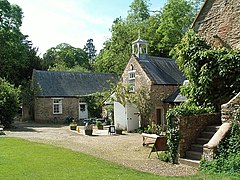Fyne Court
| Fyne Court | |
|---|---|

The cafe and shop at Fyne Court
|
|
|
Location within Somerset
|
|
| General information | |
| Town or city | Broomfield |
| Country | England |
| Coordinates | 51°04′50″N 3°06′52″W / 51.080563°N 3.114310°W |
| Client | Andrew Crosse |
Fyne Court is a National Trust-owned nature reserve and visitor centre in Broomfield, Somerset, England. It was a large English country house belonging to the Crosse family since its construction, although the date when it was built is not known.
Andrew Crosse conducted a series of experiments with electricity, including the development of large voltaic piles, at the house during his ownership in the early 19th century. The main building of Fyne Court burnt down in 1894. The buildings which survived the fire have been used as offices and a visitor centre by organisations such as the Somerset Wildlife Trust and AONB Service since it came into the ownership of the National Trust in 1967. It is surrounded by a large country estate of woodland, ponds and meadows. Within the grounds are a folly and boathouse.
The nature reserve is set in parkland which was originally the pleasure grounds of a large house belonging to pioneer 19th-century electrician, Andrew Crosse, whose family had owned the house from its construction.
Having lost his parents, his father in 1800 and his mother in 1805, Crosse took over the management of the family estates at the age of 21. Among his experiments Crosse erected "an extensive apparatus for examining the electricity of the atmosphere," incorporating at one point an insulated wire some 1.25 miles (2.01 km) long, later shortened to 1,800 feet (550 m), suspended from poles and trees. Using this wire he was able to determine the polarity of the atmosphere under various weather conditions. His results were published by his friend George Singer in 1814, as part of Singer's Elements of Electricity and Electro-Chemistry.
Along with Sir Humphry Davy (who visited Fyne Court in 1827), Crosse was one of the first to develop large voltaic piles. Although it was not the largest he built, Henry Minchin Noad's Manual of Electricity describes a battery consisting of 50 jars containing 73 square feet (6.8 m2) of coated surface. Using his wires Crosse was able to charge and discharge it some 20 times a minute, "accompanied by reports almost as loud as those of a cannon". He became known locally as "the thunder and lightning man". In 1836 Sir Richard Phillips described seeing a wide variety of voltaic piles at Fyne Court, totalling 2,500, of which 1,500 were in use when he visited.
...
Wikipedia

